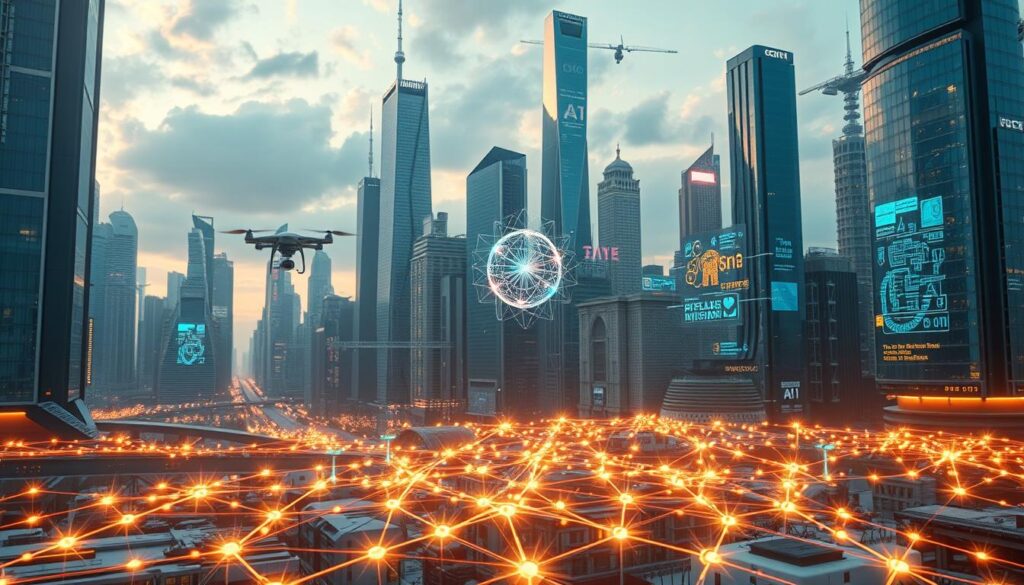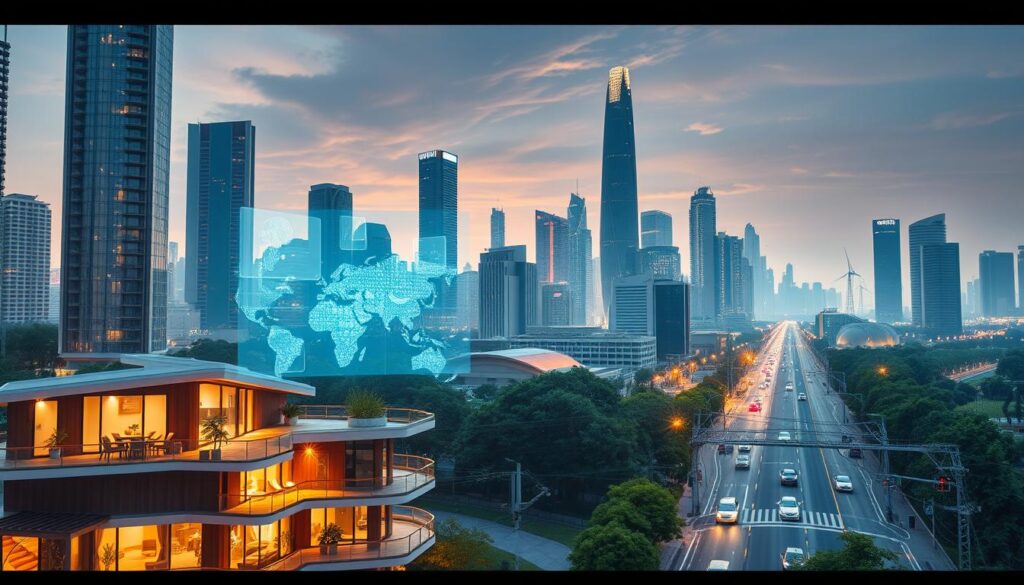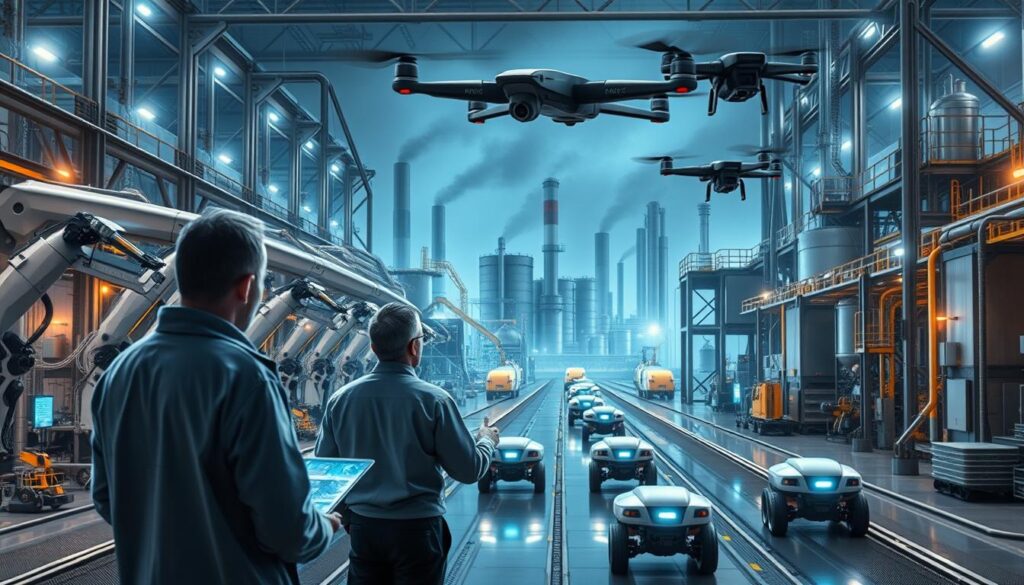As Bill Gates once said, “We always overestimate the change that will occur in the next two years and underestimate the change that will occur in the next ten.” This rings true for the rapid evolution of technology, particularly the fusion of artificial intelligence and IoT. This convergence is reshaping how devices interact, creating smarter, more connected environments.
Smart devices are now capable of real-time responses, thanks to edge computing. This advancement is crucial for applications like autonomous vehicles and industrial automation. The integration of AI and IoT enhances data collection, predictive analytics, and automated decision-making, revolutionizing industries1.
From smart homes to urban planning, this technology is transforming lives. AI algorithms analyze vast amounts of data, improving efficiency and reliability. As the global AI in IoT market grows, its impact on daily life becomes more profound2.
Key Takeaways
- AI and IoT integration enhances real-time data collection and decision-making.
- Edge computing enables faster responses in critical applications.
- Smart devices are transforming homes and industries.
- Predictive analytics improve efficiency and reliability.
- The global AI in IoT market is rapidly expanding.
Understanding the Convergence of AI and IoT

Connected devices are transforming how we interact with the world. This change is driven by the integration of artificial intelligence and IoT. Together, they create smarter systems that enhance efficiency and reliability.
What Are AI Agents and IoT?
AI agents are software programs that perform tasks autonomously. They use machine learning and natural language processing to make decisions. IoT refers to a network of physical devices connected to the internet. These devices collect and share data through sensors and embedded software.
Key components of IoT include sensors, which gather information, and embedded systems, which process it. AI enhances IoT by analyzing this data to provide actionable insights. This combination enables real-time responses and predictive analytics, revolutionizing industries3.
Recent Advancements and Their Impact
Recent advancements have significantly improved IoT capabilities. Edge computing reduces latency, making it ideal for critical applications. Machine learning models are now deployed on edge devices, enabling faster data processing4.
In healthcare, AI-driven diagnostics improve patient outcomes by 30% through personalized treatment plans3. Manufacturing benefits from predictive maintenance, reducing equipment downtime by up to 30%3. These innovations highlight the transformative power of AI and IoT.
Businesses leveraging these technologies report a 20% increase in operational efficiency3. From smart cities to industrial automation, the impact is profound. For more insights on how AI is reshaping industries, explore AI in business.
Exploring The Intersection of AI Agents and Internet of Things (IoT)

Smart systems are revolutionizing how data is processed and utilized. By combining machine learning with IoT, devices become more adaptive and efficient. This integration enables real-time decision-making, transforming industries globally5.
In smart cities, sensors collect vast amounts of information. AI analyzes this data to optimize traffic flow, reducing congestion by up to 25%5. Such advancements highlight the power of combining these technologies.
Industrial automation benefits greatly from this synergy. Predictive maintenance powered by AI reduces equipment downtime by 30%5. This leads to significant cost savings and improved productivity.
Despite the advantages, challenges exist. Merging large volumes of data with AI processing techniques requires robust infrastructure. Security and privacy concerns also need addressing to ensure seamless integration6.
Looking ahead, the possibilities are immense. Innovations in real-time processing and edge computing will drive future developments. For more insights on how AI is reshaping industries, explore AI in finance.
Implementing Edge Computing and Data Analytics

Processing data closer to the source is transforming IoT efficiency. By integrating edge computing, devices can handle information faster and more effectively. This approach reduces latency, making it ideal for real-time applications7.
Advantages of Edge Computing in IoT
Edge computing processes data near the user, cutting down delays. This is crucial for applications like healthcare monitoring and industrial automation7. By offloading tasks to edge servers, resource-limited devices perform better7.
This technology also enhances security. Lightweight protocols protect data, addressing threats like unauthorized access7. Such measures ensure safe communication in IoT networks.
Leveraging Data Analytics for Predictive Maintenance
Advanced data analytics turn IoT sensor data into actionable insights. In manufacturing, predictive maintenance reduces equipment downtime by up to 30%7. This leads to significant cost savings and improved productivity.
Healthcare benefits too. AI-driven diagnostics analyze patient data in real-time, improving outcomes7. These examples show how analytics enhance IoT applications.
Challenges exist, such as managing energy demands and ensuring data privacy. However, solutions like energy-aware architectures and decentralized trust mechanisms are emerging7.
Integrating AI into Smart Homes and Connected Cities

Innovative technologies are reshaping how we live and interact with our surroundings. By combining machine learning with IoT, homes and cities are becoming smarter and more efficient. This integration is transforming everyday life, from energy management to urban planning.
Smart Home Automation and Energy Efficiency
Smart homes leverage IoT devices to optimize energy usage. Thermostats, lighting, and appliances adjust automatically based on user patterns. This reduces energy consumption by up to 30%, saving costs and promoting sustainability8.
AI-driven systems analyze data from sensors to predict user needs. For example, smart thermostats learn preferences and adjust temperatures accordingly. This level of automation enhances comfort while minimizing waste8.
Enhancing Urban Infrastructure with AI-Driven IoT
Connected cities use IoT sensors to improve traffic flow and public safety. In Barcelona, smart waste management systems reduced greenhouse gases by 90%8. Such innovations showcase the potential of AI in urban management.
Machine learning algorithms analyze data from sensors to optimize public services. For instance, smart grids manage electricity distribution efficiently, reducing outages and costs9. These advancements highlight the transformative power of AI and IoT.
Looking ahead, the integration of these technologies will continue to evolve. Smarter communities will offer enhanced services, improved resource management, and a better quality of life. The future of connected living is bright, driven by innovation and intelligence.
Adopting AIoT in Industrial and Healthcare Sectors

Modern industries are leveraging advanced technologies to streamline operations. By integrating AI with IoT, businesses achieve higher efficiency and better outcomes. This synergy is transforming both manufacturing and healthcare, addressing critical challenges and improving processes10.
Industrial IoT for Improved Efficiency
In manufacturing, AI-powered IoT systems enable predictive maintenance. This reduces equipment downtime by up to 30%, saving costs and boosting productivity10. Real-time data analysis helps identify potential issues before they escalate, ensuring smoother operations.
These systems also optimize resource allocation. By analyzing production data, manufacturers can minimize waste and improve output quality11. This approach enhances overall efficiency, making industries more competitive.
Transforming Healthcare with Remote Monitoring
Healthcare is witnessing a revolution with AIoT applications. Remote monitoring devices collect patient data in real-time, enabling timely interventions11. This is particularly beneficial for chronic disease management, improving patient outcomes significantly.
AI-driven diagnostics ensure accuracy, with classification rates exceeding 99.99%10. Such precision reduces misdiagnosis risks, enhancing patient safety. These advancements highlight the potential of AIoT in transforming healthcare delivery.
Challenges like data privacy and network security remain. However, solutions like decentralized trust mechanisms are emerging to address these issues10. The integration of AI and IoT continues to redefine healthcare, offering smarter and more efficient solutions.
Overcoming Security, Privacy, and Interoperability Challenges
Security concerns are growing as IoT devices become more widespread. With billions of interconnected devices, protecting user data and ensuring system integrity are critical. AI-driven solutions are emerging to address these challenges, offering advanced threat detection and mitigation12.
Strengthening IoT Security with AI Solutions
AI enhances IoT security by identifying unusual patterns in data. For example, machine learning algorithms can detect anomalies in network traffic, preventing unauthorized access12. In 2020, a Tesla Model X was hacked in less than 90 seconds due to a Bluetooth vulnerability, highlighting the need for robust defenses12.
Healthcare is particularly vulnerable, with 59% of IP cameras in clinical settings having critical security flaws12. AI-powered systems can monitor these devices, ensuring compliance with safety standards and reducing risks12.
Ethical Considerations and Data Privacy
Increased data collection raises privacy concerns. Regulations like GDPR and California Senate Bill 327 aim to protect user information, requiring IoT devices to avoid default passwords and enable vulnerability patching12.
Ethical AI practices are essential to ensure transparency. Users must understand how their data is used and have control over its management12. For more insights on balancing innovation and privacy, explore AI-IoT integration.
Interoperability remains a challenge, as devices from different manufacturers often lack compatibility. Industry standards are crucial to creating seamless, secure IoT ecosystems13. Addressing these issues ensures a safer, more connected future.
Future Trends and Innovative Developments
Emerging technologies are paving the way for a smarter, more connected future. From 5G networks to advanced edge AI capabilities, these innovations are transforming how devices interact and process data. This evolution is reshaping industries and daily life, offering new possibilities for efficiency and sustainability.
Emerging Technologies: 5G, Edge AI, and Beyond
5G technology is revolutionizing IoT connectivity, enabling faster data transfer and lower latency. This advancement is crucial for applications like autonomous vehicles and remote healthcare monitoring14. Edge AI, on the other hand, processes data closer to the source, reducing delays and enhancing real-time decision-making15.
Wireless communication technologies like Zigbee and LoRaWAN are also gaining traction. These solutions enable low-power, long-range communication, essential for remote monitoring applications14. Together, these technologies are driving the next wave of IoT innovation.
Economic and Social Implications of AIoT
The integration of AI and IoT is expected to generate a market size of $1.6 trillion by 202514. This growth is fueled by advancements in predictive maintenance, which reduces equipment downtime by up to 30%14. Industries like manufacturing and healthcare are reaping the benefits, improving efficiency and patient outcomes.
Smart cities are leveraging AIoT to optimize resource management, reducing energy consumption by 30%14. However, challenges like data privacy and security remain critical. Addressing these issues ensures a safer, more connected future for all.
Conclusion
Innovation continues to redefine how technology shapes our daily lives. Combining machine learning with IoT devices enhances efficiency across industries. From smart homes to urban planning, this integration transforms how users interact with the world16.
Real-time data analytics and predictive maintenance drive significant improvements. In manufacturing, downtime is reduced by up to 30%, while smart cities optimize resource management17. These advancements highlight the power of intelligent systems.
Challenges like security and interoperability remain critical. Addressing these ensures seamless adoption of these technologies. Continued innovation will shape the future, creating smarter, more connected environments for all.
FAQ
What are AI agents and IoT?
How does edge computing benefit IoT?
Can AI improve predictive maintenance in IoT?
How does AI enhance smart home automation?
What role does AI play in connected cities?
How is AIoT transforming healthcare?
What are the security challenges in IoT?
What ethical concerns arise with AIoT?
What emerging technologies are shaping AIoT?
What are the economic impacts of AIoT?
Source Links
- Integrating Artificial Intelligence Agents with the Internet of Things for Enhanced Environmental Monitoring: Applications in Water Quality and Climate Data
- The Intersection of AI and Internet of Things (IoT): Advancing Intelligent Automation – AI Trends India
- The Intersection of AI and IoT: Smart Solutions for Modern Problems
- AIoT Explained: The Intersection of AI and the Internet of Things
- Exploring the Synergy of AI and Internet of Things (IoT)
- The Intersection of AI and IoT: Building Smarter Systems
- Combining Edge Computing-Assisted Internet of Things Security with Artificial Intelligence: Applications, Challenges, and Opportunities
- The Intersection of AI, Blockchain, and IoT: A Trifecta for Smart Cities
- Integration of IoT-Enabled Technologies and Artificial Intelligence (AI) for Smart City Scenario: Recent Advancements and Future Trends
- Sustainable Smart Industry: A Secure and Energy Efficient Consensus Mechanism for Artificial Intelligence Enabled Industrial Internet of Things
- Artificial Intelligence of Things: A Survey
- What is IoT Security? | TechTarget
- Frontiers | Internet of Robotic Things Intelligent Connectivity and Platforms
- AI Agents for IoT Sensor Integration 2025
- Future Trends in AI Chips | Restackio
- The Intersection of AI and IoT: Smart Devices and Connected Environments
- Where AI Meets IoT: Creating Smart, Connected Spaces







